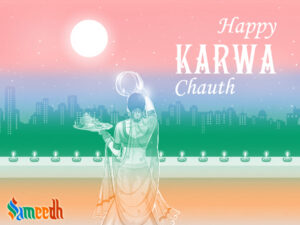Karva Chauth is a traditional Hindu festival observed by married women for the well-being and longevity of their husbands. It involves fasting from sunrise to moonrise, and the day concludes with a special puja (worship) performed in the evening.

Here is a general guide on how to perform the KarvaChauth Puja:
Preparations:
- Select an Auspicious Time:
- Consult a Hindu calendar or a priest to determine the exact timing of sunrise and moonrise for your location.
- Fasting:
- Married women observe a day-long fast, abstaining from food and water, from sunrise to moonrise. This fast is broken only after sighting the moon.
- Puja Items:
- Arrange the necessary puja items, including a Karva (a small pot), water, raw rice, a small pitcher of water, flowers, vermilion, a diya (oil lamp), fruits, sweets, and other offerings.
Evening Puja:
- Sargi:
- Early in the morning, before sunrise, the woman eats Sargi, a pre-dawn meal prepared by her mother-in-law.
- Preparation for Puja:
- Clean the puja area and set up the necessary items.
- Dressing Up:
- Dress up in traditional attire, preferably in red or bridal colors.
- Sighting the Moon:
- Gather with other women in the evening to sight the moon. Once the moon is visible, it’s time to break the fast.
- Puja Thali:
- Arrange all puja items on a thali (plate) or in a special puja area.
- Karva Chauth Katha:
- Begin the puja by reading or listening to the Karva Chauth Katha, which narrates the story associated with Karva Chauth.
- Water Offering (Arghya):
- Offer water to the moon while reciting prayers. The reflection of the moon is seen in a plate of water.
- Offering to the Moon:
- Offer raw rice, flowers, and vermilion to the moon.
- Breaking the Fast:
- The husband gives water to his wife to break her fast. Some also have a piece of fruit or sweet at this time.
- Husband’s Blessings:
- The husband may give a token of appreciation or a gift to his wife and bless her.
- Sweets and Food:
- The woman can now consume a meal to end the day-long fast.
- Family Blessings:
- Elders in the family may offer their blessings to the couple.
Additional Traditions:
- Sindoor (Vermilion) Application:
- Some women apply sindoor to their foreheads as a symbol of a happy and long married life.
- Gift Exchange:
- The husband may give gifts to his wife, and the wife may receive gifts from other family members.
- Ceremonial Dressing:
- Some women may dress in bridal attire and apply mehndi (henna) on their hands.
Note:
- The specifics of the puja may vary based on regional customs and family traditions. It’s advisable to follow the practices that are culturally significant to you.
- Some families choose to have a more elaborate celebration, including inviting friends and family for a communal moon sighting and breaking of the fast. Others prefer a more intimate celebration within the family.
- Seeking guidance from elders or consulting with a priest can help ensure that the rituals are performed correctly according to your cultural background.